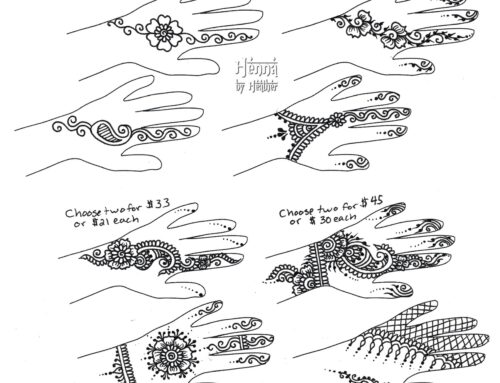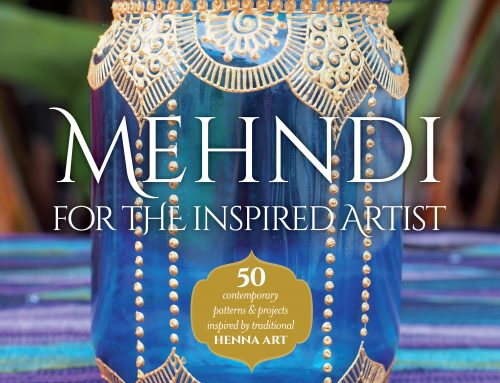Every event is different, and so is every henna artist. Making sure you find an artist who is the right fit for you and your event can greatly contribute to the event’s success.
Of course, there are some things to look for in general, to help you find a truly professional artist, whose work and professionalism you can trust. Once you’ve gotten these first few basics confirmed, then it’s time to check and see if the artist is a good fit for your event.
1. Do they use natural henna?
First off, you want to be very sure that your artist is using real henna, made from the leaves of the henna plant. They should be able to readily list the ingredients in their paste when you ask. They should not be using cones bought off the shelf at a grocery store, as these either were natural henna but have lost their potency, or were never natural to begin with. The very biggest thing to be sure of is that they are not using so-called “black henna”, which is actually PPD, a chemical dye used for industrial purposes and as hair dye. There is a reason you are not supposed to get black hair dye on your scalp/skin – it can cause serious skin wounds and other health problems. But even if the artist is using red/brown henna, just quickly double-check with them about what their ingredients are. A list should quickly roll off the artist’s tongue, without any hesitation at all. The number one ingredient is henna leaves, followed by some mixing liquid (lemon juice, tea, apple juice, and water are all common), and then typically some essential oil (cajeput, lavender, tea tree, niaouli, and geranium are some common ones; beware of eucalyptus as only some variants are actually skin-safe).
There is a certification for natural henna artists, the ICNHA, but not all artists using natural henna have it, and it is not necessary to possess this to work as a henna artist professionally. If your artist has it, awesome, they’ve made it easy for you to confirm their commitment to using natural henna! If they don’t, just ask them what’s in their paste.
2. Are the henna designs displayed on their signage, brochures, online presence, etc all their own?
Believe it or not, image theft is a common problem in the world of henna. Some artists will be so bold as to crop out other artists’ watermark, and/or add their own watermark over an image that doesn’t have one. The main way to know this is to look for similarities in the look and feel, overall quality, and stylistic aspects of both the henna itself and the photography. There will be some variation in any artist’s work, but if every image looks like it could have been done by a different hand and taken with different camera, chances are quite high they were!
Festival design books, on the other hand, are often filled with line art by multiple artists. This art should always have the copyright information for the original artist and book intact. Artists do pay other artists whose work they admire and are confident that they can replicate for the rights to use those images in design books to be shown in person at events they are working. There is a whole culture of sharing ebooks of designs among henna artists, just like there is with tattoo artists sharing posters of flash images.
Those two factors are easiest and quickest way to determine if you’re dealing with someone who is doing henna responsibly.
So, beyond the two total essentials, what else should you consider in your henna artist? There are a few different categories of things to consider to make sure your henna artist is the best fit for your needs.
1. Artistry and Style
Does the henna artist’s style match your own aesthetics? Do they have a specialty that they seem to focus on? Can they do a good job with any style you throw at them? If you want intricate bridal henna, be sure that they have examples of that in your portfolio. If it’s important to you that they be able to do whatever people at your event may ask for, check for diversity of styles, and especially skill with drawing figural elements (always the hardest!), to ensure that they can rise to the occasion no matter what the request is. If you prefer that all your guests have henna that matches a certain traditional style, look for someone who whose portfolio shows that they are well versed in that style.
2. Speed
Speed is key in deciding who to book as your henna artist. A professional working henna artist should be able to do a wrist-to-fingertip “strip” guest hand design that is standard at wedding mehndi parties in about 5 minutes per person (3 minutes doing the actual henna, plus a couple for design selection and explaining care). Bridal design takes more focus and concentration, and typically has finer details as well as more intricate coverage, so it takes between 2-5 hours for hands only, depending on what is being done.
Typically an artist’s rate will be largely determined by speed. If you hire an artist at half the going rate, but they work half as fast, you’re actually hiring them at the same price for the actual work done, and you are not getting the bargain you maybe thought you were. Faster, more experienced artists will tend to have higher hourly rates, as they are getting more work done within that time. Some artists do truly stunning, detailed work, but need longer than average to complete that work. Find someone with the right balance of speed and neatness/intricacy that is right for your needs.
Because speed is so key in determining rates, artists will often be quick to tell you how many designs they can do in what amount of time. Check and see what those designs actually look like. They should have multiple examples.
2. Professionalism
You want someone who is passionate about doing henna, who also realizes that once an artist-client relationship is established, a certain degree of professionalism is required. They should require a contract and booking fee to secure your date. You would not believe how many calls henna artists get from potential clients who are desperate because the artist they didn’t officially have a contract with but thought they had booked flaked out at the last minute or simply didn’t show up. A professional will always require a booking fee and signed contract or other written agreement, and this officially locks in the client’s desired date and time. The contract sets out very clear expectations, and makes sure everyone is on the same page. How many guests will the artist be expected to henna, and in what amount of time? What is the agreed upon rate? Are there additional fees?
While having a good contract be part of booking them is key, there are other marks of a truly professional henna artist. Are they prompt about returning your messages? Do they communicate clearly? Do they inspire confidence in you? Can they answer all your questions?
3. Official Stuff
Most professional henna artists are insured. You can request a copy of their insurance certificate if you would like; typically large corporations, colleges, and festivals require it, but private parties do not see it as necessary. If your henna artist is being hired by these big-time clients, they will, by necessity, have insurance. They may not loudly announce it, especially if they see it as very obvious that they would have it since they have a very legitimate business, but if you ask, they can explain their coverage to you and provide proof of it.
Your henna artist should also be registered as a business with their state and/or municipality. They should be paying taxes on their income from doing henna, and if you need a W-9 from them for your own tax purposes, they should be happy to provide you with one.
4. Working Method
Does your artist require design books to copy from? Do they specialize in creating new, unique designs on the fly? Do you have a sense that they are intuitive and will be good at understanding what people would like? Do they take requests, and can they deliver on just about any of those requests?
Working out of design books slows down the workflow at your event. People spend forever browsing through the existing designs and negotiating changes to those designs. But sometimes, it’s important to you that your guests be able to see exactly what their options are, even if providing a particular catalog by necessity limits those options and slows things down. Can the artist bring a book of designs for guests to look through if you’ve decided that is truly important to you?
5. All the Intangibles
Sometimes you just get a good feel about someone, and sometimes you just get a bad one. Go with your gut! Your artist should inspire confidence, excitement, and happiness for your upcoming event. You should feel like you can trust them to do an excellent job.


